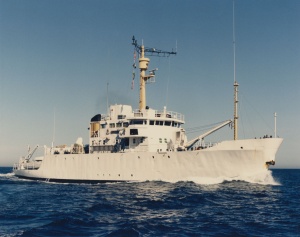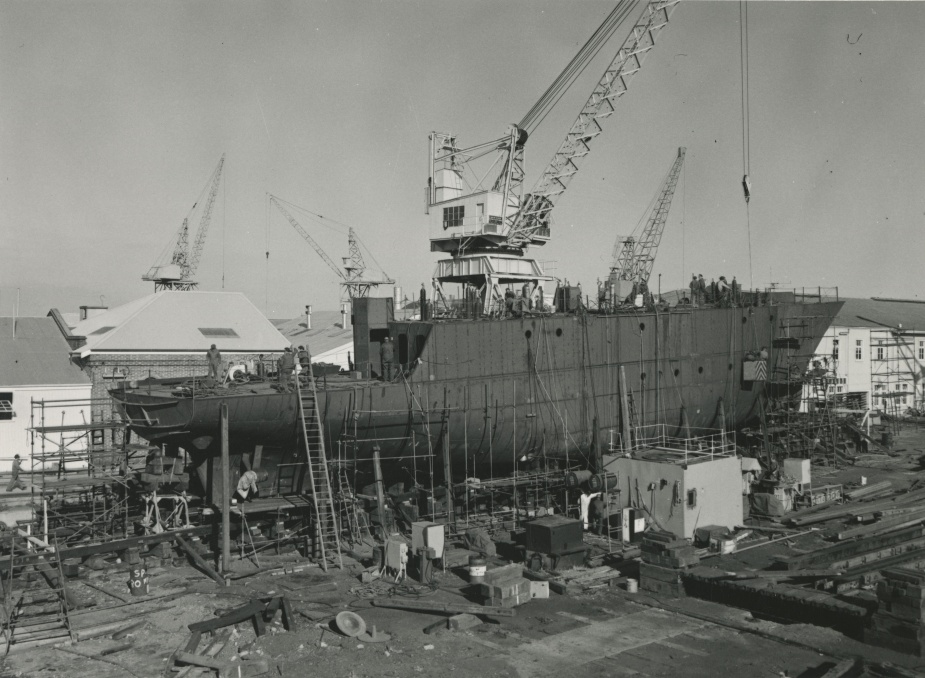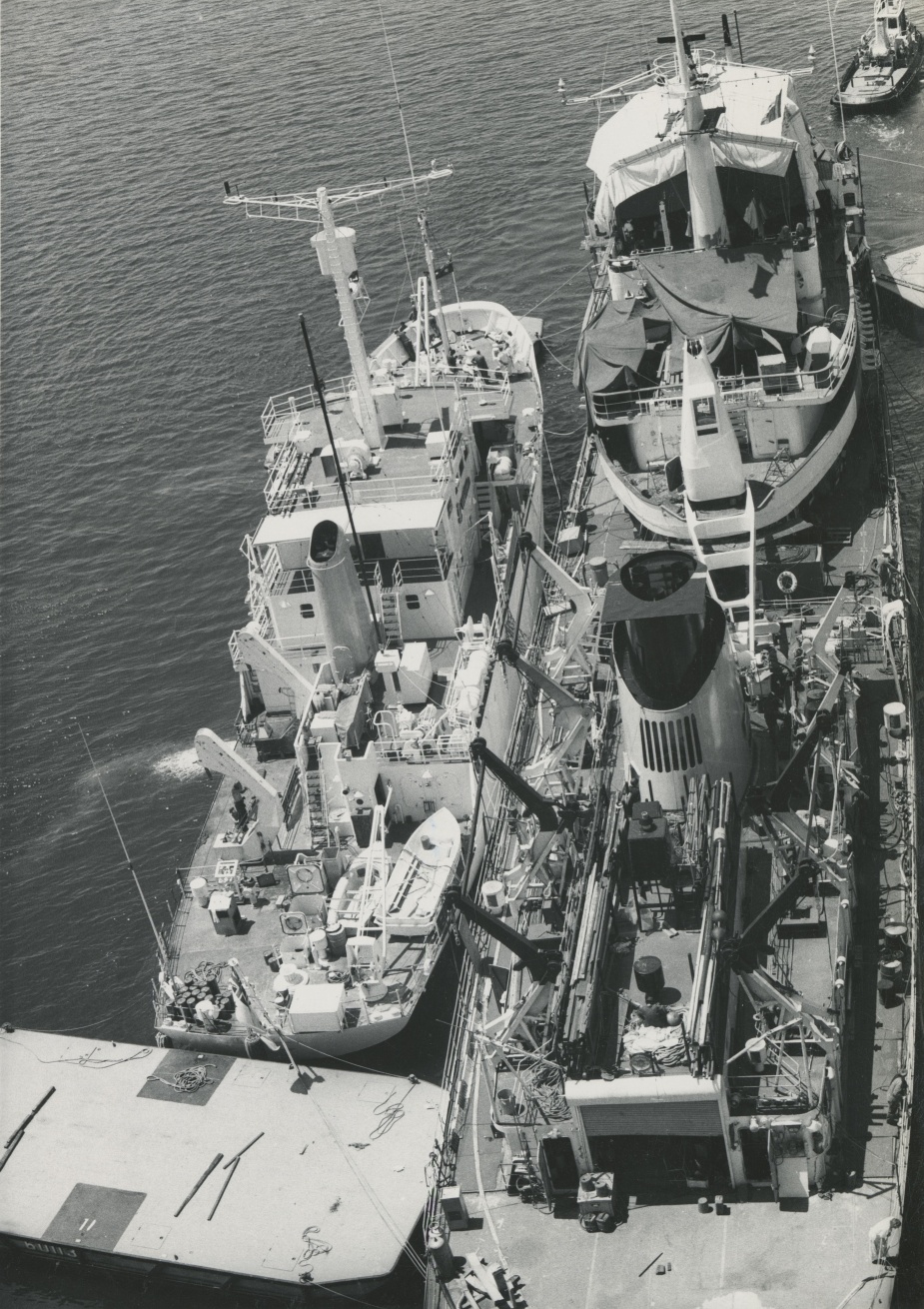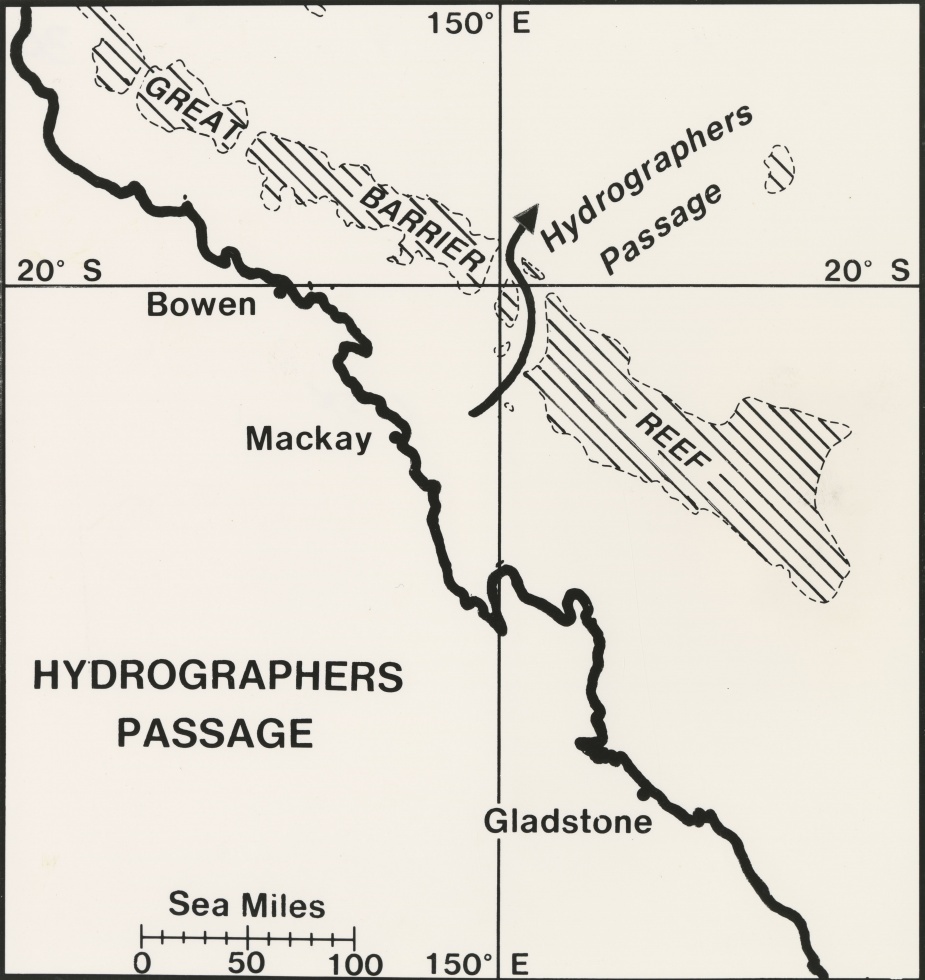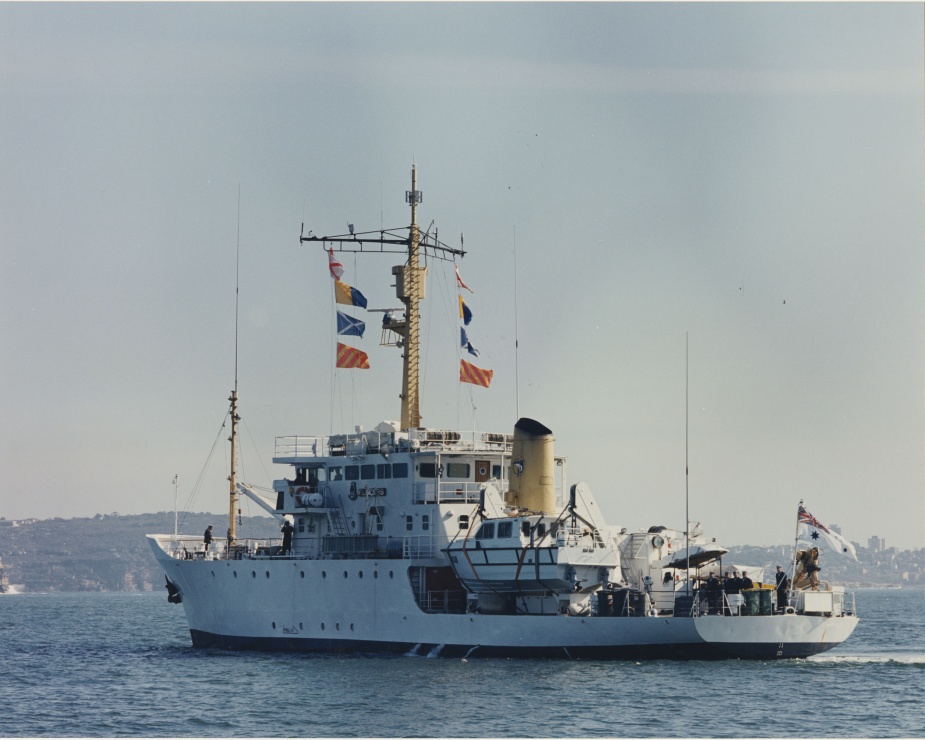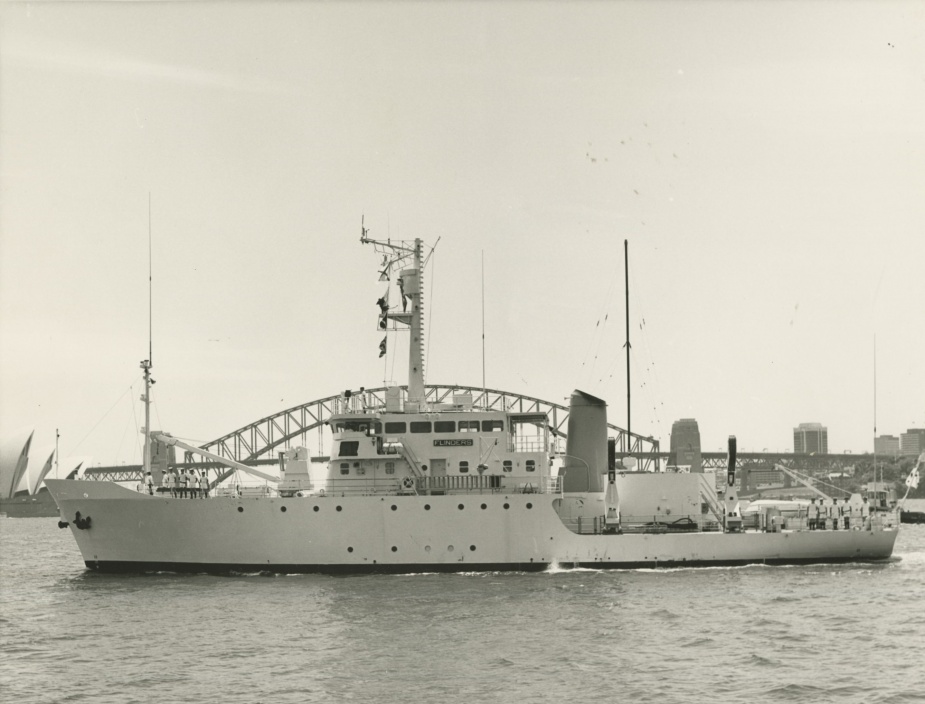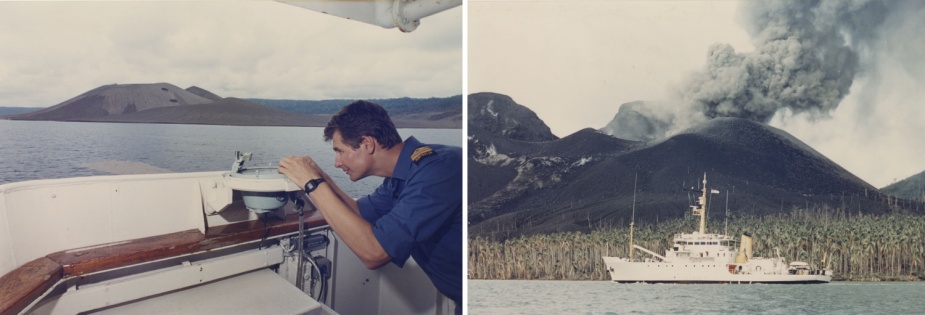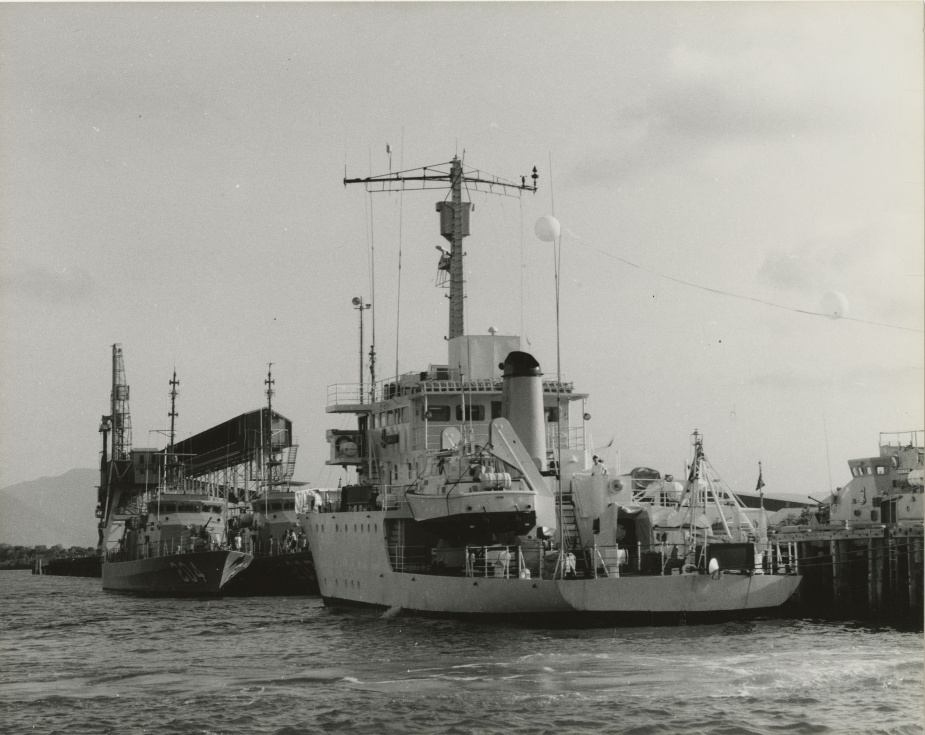HMAS Flinders
| Type |
Survey Ship |
|---|---|
| Pennant |
A 312, GS 312 |
| Home Port | |
| Builder |
Williamstown Naval Dockyard |
| Launched |
29 July 1972 |
| Launched by |
Mrs Ruth Mackay, wife of the Minister for Navy Dr Malcolm Mackay |
| Commissioned |
27 April 1973 |
| Decommissioned |
12 October 1998 |
| Fate |
Sold by tender |
| Dimensions & Displacement | |
| Displacement | 825 tonnes |
| Length | 49 metres |
| Beam | 10 metres |
| Draught | 3.66 metres |
| Performance | |
| Speed | 13 knots |
| Complement | |
| Crew | 6 officers and 36 sailors |
| Propulsion | |
| Machinery |
|
| Armament | |
| Guns | .50 Calibre Machine Gun |
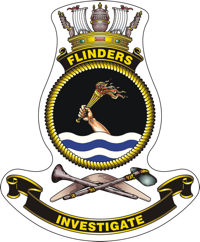
HMAS Flinders was ordered on 11 August 1970 as a replacement for the hydrographic survey ship HMAS Paluma (III). She complemented the Royal Australian Navy’s larger, helicopter capable hydrographic vessel, HMAS Moresby (II), which commissioned in 1964. The ship's name was chosen for two reasons; firstly to commemorate the memory of the 18th century Royal Navy officer Lieutenant Matthew Flinders who had explored and charted much of the Australian coastline; and secondly, to commemorate 50 years since the formation of the RAN Hydrographic service, Flinders being regarded by surveyors as one of the forefathers of modern hydrography.
The ship was designed by the Australian Shipbuilding Board in conjunction with Naval Technical Services, and was a variant of the RPS Atyimba built for the Philippines in 1969. Built at Williamstown Naval Dockyard in Victoria, Flinders was laid down in February 1971 and launched 18 months later at an approximate cost of $2m to build and $1.1m to fit out.
In her role as a hydrographic survey ship, Flinders and her 10.5 metre embarked jet powered survey motor boat (SMB) collected data required to produce safe navigational charts. This entailed determining depth and position simultaneously, observing and recording the rise and fall of the tide to reduce attained depths to a common datum, ascertaining the nature of the seabed, accurately fixing the coastline, conducting sonar sweeps for total coverage, compiling and correcting sailing directions, and conducting and recording oceanographic observations.
To achieve this, Flinders was equipped with an array of modern surveying equipment giving her a capability that included deep and normal range echo sounders, sonar, electronic navigational aids and towed side scanning sonar.
HMAS Flinders commissioned on 27 April 1973 at Williamstown Naval Dockyard in Melbourne, Victoria, under the command of Lieutenant Commander Ian Pullar, RAN. She remained in dockyard hands until the end of May completing her fit-out and various builder’s sea and harbour trials. As with many first of class or type platforms, Flinders experienced teething problems. These hindered the successful completion of the trials, with the ship being finally accepted into service on 1 June 1973. For the remainder of the month, the ship operated in coastal Victorian waters, setting the ship to work as well as addressing the post-delivery defect list. From July until November Flinders remained in refit and post-delivery availability. On completion of post refit trials, Flinders finally departed Williamstown Naval Dockyard on 14 November 1973 to proceed to Sydney where she stayed for the remainder of the year.
Following defect rectification in the hands of Garden Island Dockyard staff, Flinders departed Sydney on 29 January 1974 for the transit to her designated homeport of Cairns, conducting minor survey work en route.
It was from Cairns that Flinders conducted the majority of her survey work, with areas surveyed including the Great Barrier Reef, Torres Strait, the Gulf of Carpentaria, Bass Strait, Arnhem Land, Norfolk Island, north-western Australia and Papua New Guinea.
In early 1974, Flinders undertook her first survey task in the Adolphous Channel area (Torres Strait) until the end of March. She underwent a refit in Cairns from the middle of July until the end of September and in early October returned to the Torres Strait survey ground. Apart from the periods alongside in Cairns, Flinders also made visits to Thursday Island, Weipa and Karumba. As with much of the RAN, the well-earnt Christmas Leave for the ship’s company was cut short that year, as the RAN Fleet went to the assistance of cyclone ravished Darwin.
Flinders ‘crash sailed’ on Boxing Day 1974 and spent the New Year sounding the approaches to the Port of Darwin. This was in preparation for the arrival of the RAN Task Group due to conduct relief operations in response to Cyclone Tracy. Clearing the entrance to Darwin Harbour and the Task Group’s designated anchorage area was the priority for Flinders, and her contribution proved critical to the relief effort. The remainder of her time in Darwin waters was spent identifying other submerged obstructions and debris within the harbour confines. She completed operations in Darwin on 9 January 1975 before returning to Cairns.
Flinders resumed hydrographic operations in February in the Cape Melville - Barren Island area, before undertaking a short maintenance period. She later steamed north, visiting Kieta, Bougainville, in April for Anzac Day commemorations. She then carried out hydrographic operations in Papua New Guinea and the Solomon Islands, which included a port visit to Rabaul in May and to Honiara in June. July 1975 saw the ship conduct a refit in Cairns, before returning to sea in October and carrying out survey operations within the Flinders Island group and later the Tijou Reef to Lowry Passage. In late November she returned to Cairns for a well-earned leave and maintenance period.
Flinders’ 1976 survey season began in the Mackay region and Whitsunday Island group, where her crew worked steadily for eight weeks. Following Easter and a routine maintenance period, the ship visited Port Moresby for Anzac Day before proceeding further north to the Trobriond Islands for survey tasks extending as far as New Britain. Following a port visit to Rabaul in mid-May, she briefly conducted an unsuccessful search for the wreck of the Australian WWI submarine AE1, which had failed to return from a patrol in that area in September 1914. During that time her crew observed the residual eruption cloud from the active volcano, Mount Munlulu on north-west New Britain. For respite during the survey, a port visit to Lae was included in the programme, before Flinders returned to Cairns at the end of June for refit.
During the refit, a hole in the shell plating of the ship’s forward trimming tank was discovered, requiring emergency docking in the William Angliss dry dock in Cairns, a facility that had previously been considered too small to accommodate Flinders. The repairs to the trimming tank delayed proceedings and the ship did not complete her refit until the end of October.
In spite of the delay, Flinders was soon back at sea, proceeding to the Cape Grenville, Cape Weymouth and Cape Flattery area survey grounds where she was to spend the next month. The remainder of November and December saw her return to Cairns for Christmas leave and routine maintenance.
On 10 January 1977 Flinders returned to the Cape Weymouth survey grounds. Hydrographic operations were marred, however, by numerous survey equipment failures. Such failures had affected Flinders’ since commissioning, an observation highlighted in her monthly reports of proceedings, as was the impact on survey operations and the morale of the crew. February however, proved to be a more productive month on the survey grounds with much achieved. Notably, Flinders proved that a clear passage existed to Black Rock Entrance entering from the Inner Route either between Bourke Reef and Curd Reef or between Dolphin Reef and Eel Reef.
Following the Easter break in Cairns, Flinders proceeded to the Endeavour Strait survey area. Survey operations continued in that area and the Gulf of Carpentaria until the end of June, at which time the ship made a port visit to Gove. July through to September was spent undergoing maintenance before proceeding to the Torres Strait survey grounds at the end of September for her final hydrographic operation of the year. She returned to Cairns in mid-November.
From early January to late March 1978, Flinders conducted a survey of Cape Grenville and its surrounds returning to Cairns as required for respite, fuel and stores. In April the ship proceeded to Papua New Guinea for three months of hydrographic operations between Green Island, New Hanover and Lyra Reef, visiting Kavieng, Rabaul and Manus Island as required. She also took the opportunity to conduct a further search for the wreck of AE1 but again it was to no avail. While on her return passage to Australia, the ship assisted Australian customs with retrieving a large quantity of drugs found aboard the wreck of the Amagi Maru at Pocklington Reef.
Flinders began a maintenance period in July, which involved rectifying a number of engineering defects. Her crew however was not idle, and in September and October the ship’s boats and shore parties were deployed to conduct survey work in and around the immediate Cairns vicinity. Returning to sea in November, Flinders continued survey operations in the vicinity of Low Island and Port Douglas, but was still plagued by mechanical defects as well as survey equipment problems.
In January 1979 Tropical Cyclone Greta crossed the Cape York Peninsular threatening Cairns. As a precaution, Flinders expedited storing ship and sailed. Happily for all concerned, the cyclone lost intensity before reversing course, enabling Flinders to commence survey operations in the vicinity of Thursday Island and Torres Strait. The survey continued until mid-March, before returning to Cairns for routine maintenance.
Following the Easter break, Flinders conducted hydrographic operations in the Adolphous and Raine Island areas with initial assistance from HMAS Balikpapan. Survey operations were interrupted in early May, when Flinders was diverted to escort HMAS Bayonet through reef waters in the vicinity of Three Reefs to apprehend an illegal foreign fishing vessel. With her escort duty completed, Flinders returned to survey operations but was to face further interruptions in May and June, with ship generator failures and bad weather necessitating unscheduled visits to Cairns and Thursday Island.
Returning to Cairns the ship underwent her annual refit from July to November during which time the ship’s company conducted local area harbour surveys. For the remainder of November limited survey operations were conducted in the vicinity of Dunk, Russell and North Barnard Islands.
The New Year saw Flinders alongside at Cairns undergoing repairs to her main engines before resuming survey duties in the vicinity of Dunk and Frankland Island. This work continued from February through to the beginning of April. Easter was spent in Cairns before survey operations resumed in the Gulf of Carpentaria. Frustratingly, ongoing problems with her port main engine forced a premature return to Cairns in mid-May to effect repairs and attend to other maintenance tasks. During that time, the ship’s survey parties again competed regional tasking making good use of Flinders SMB. Flinders returned to sea on 10 October and was soon conducting survey operations to the south of Cairns and inner reef until the end of November.
Flinders commenced her 1981 survey program in mid-January in the Raine Island to Adolphous Island areas, before returning to Cairns in May for docking and a maintenance period. Flinders returned to sea on 29 July to conduct what would prove to be among the most significant survey operations of her commission in the approaches to Hay Point, Bugatti Reef and other inner reef areas. In addition to regular visits back to her home port, she also made port visits to Mackay in August and Bowen in October. This survey, and that of the following year, would confirm the existence of an alternate deep passage route through the Great Barrier Reef, which would be named ‘Hydrographers Passage’ as a tribute to those who for centuries had toiled at tedious charting tasks for the safety of mariners at sea. In 1802 Matthew Flinders himself had attempted to locate a passage through the reef in this area but success was to elude him and the many others that followed in his wake.
Flinders put to sea on 18 January 1982, returning to the Hay Point survey grounds where she remained, using Mackay as a replenishment port until April. Following Easter leave and an assisted maintenance period in Cairns, Flinders laboriously ‘fine-tuned’ the previous year’s work and discoveries to determine the nature of the deep passage route amongst the reefs, sand banks and isles that traversed from the inner to the outer reef area. In recognition of this achievement, Flinders was awarded the Royal Geographic Society of Australasia ‘JP Thomson Foundation Medal’ in 1985 for ‘a valuable and permanent benefit to Australia’s maritime trade’.
In early May 1982 Flinders returned to the Gulf of Carpentaria and Endeavour Strait survey grounds until mid-July. From August to mid-October the ship was in an extended assisted maintenance period using, for the first time, the new undercover facility at HMAS Cairns naval base. For the remainder of October until 18 November Flinders conducted survey tasks in the Trinity Opening environs before spending the rest of the year alongside Cairns for Christmas leave and an assisted maintenance period.
Flinders sailed on 17 January 1983 to return to the Holbourne Island and Bugatti Reef survey grounds to assist in determining where future navigational aids should be located to define Hydrographers Passage. The ship then returned to the Gulf of Carpentaria survey grounds on 17 April where she operated until the end of May using Weipa as a forward support base. From June to September Flinders conducted her annual refit in Cairns and, apart from post-refit sea trials in early October, remained alongside in an assisted maintenance and leave period for the remainder of the year.
Flinders departed Cairns on 9 January 1984 for survey tasks in the vicinity of Nymph Island and Hydrographers Passage using Hay Point and Mackay as forward support bases. These tasks were interrupted when the centreline anchor was lost, necessitating a brief return to Cairns to collect a replacement. On 21 February, while en route to Cairns, Flinders participated in a Maritime Search and Rescue operation to assist the fishing vessel Grampus which had run aground on Stanley Reef. She resumed survey operations in the Hay Point area in March and in July returned to the survey grounds in the Gulf of Carpentaria, and afterwards in the Torres Strait. From September to November surveys were conducted from Brooke Isles to Albino Rock in the main inner reef shipping route, and the High Peak Island exercise area to the north of the Shoalwater Bay exercise areas.
Following the 1985 Australia Day long weekend, survey work was undertaken in the vicinity of Barrow Island, Ingham Island and Lizard Island. However, a catastrophic failure in the port main engine necessitated a return to Cairns in mid-February for an engine change out. An attempt to return to sea was again thwarted at the end of the month by yet another mechanical failure and it was not until early March that the ship returned to the Lizard Island survey grounds followed by a four day visit to Port Vila, Vanuatu, on 25 March.
Flinders commenced her annual refit upon her return to Cairns in April before returning to the Cape Flattery and Lizard Island survey grounds, working in company with HMAS Betano, throughout July. She returned to Cairns in September for an assisted maintenance period before undertaking survey operations in the Willis Islets and Diamond Passage area. The remainder of the year was spent in Cairns with time spent conducting surveys in the vicinity of Mackay, Willis Island and Lihou Reef tracking from Hydrographers Passage to the entrance of the Jomard Passage.
Survey operations resumed in February with Flinders operating chiefly in the western approaches to the Torres Strait. Flinders remained alongside in Cairns for most of April putting to sea for only a few days to avoid a monsoon trough which evolved into Tropical Cyclone Namu. She departed Cairns at the end of the month for a 10-week survey task on the north-east coast of Papua New Guinea concentrating on an area bounded by Star Reefs, Ward Hunt Strait and Vitiaz Strait.
Flinders suspended hydrographic operations around Star Reef on 23 May in order to provide humanitarian assistance to the Solomon Islands in the aftermath of Tropical Cyclone Namu. Namu struck the Solomons on 18 May bringing heavy, prolonged rain and causing mudslides. More than 100 people were killed and 1,000 injured, and 90,000 were left homeless. The cyclone also caused extensive damage and casualties in Vanuatu and New Caledonia. As the first RAN ship on site, Flinders conducted a rapid survey of Honiara Harbour before ferrying food and relief stores to the outer islands. HMA Ships Stalwart, Betano and Brunei also contributed to RAN relief operations. On completion, Flinders returned to the PNG survey area in June remaining there until 19 July before returning to Cairns, via Port Moresby, on 25 July.
An assisted maintenance period in August saw the ship prepared for her next survey which would take her south to Bass Strait. Flinders sailed from Cairns on 25 August to begin two months of hydrographic operations in the Bass Strait. Notable port visits during that time included calls at Portland and Adelaide. During the southern deployment Flinders visited Sydney for only the second time since commissioning and was appointed lead ship for an International Fleet Review on 4 October to commemorate the seventy-fifth anniversary of the granting of the ‘Royal’ title to Australia’s Navy. On 18 October she also participated in a re-enactment of the 1802 meeting between Matthew Flinders (represented by HMS Amazon) and Nicholas Baudin (FNS Commandant Blasson) in Encounter Bay, South Australia. She returned to Cairns at the end of November where she entered a leave and maintenance period that would extend into the New Year.
Flinders resumed hydrographic operations in mid-January in Arnhem Land in the area between the Wessel Islands and Gove Peninsula. This survey task was interrupted on three occasions by cyclone avoidance alerts. The ship returned to Cairns in April where she underwent a refit until the end of August. She then returned to the Torres Strait survey grounds in September, remaining there for the next three months focussing on the western approaches to the Simpson Channel with a view to determining whether it would prove an alternate deep water passage to the Prince of Wales Passage. Other than returning to Cairns for resupply and repairs she remained in that area during which time she visited Thursday Island, Weipa and Port Moresby. She then returned to Cairns in December for Christmas leave and routine maintenance.
In February 1988 Flinders returned to the Gulf of Carpentaria and Torres Strait for further survey tasks remaining there until the end of April. Operations were briefly interrupted in mid-February when the ship encountered problems with its rudder, requiring 10 days in Darwin to effect repairs. The ship celebrated Easter at Cairns and undertook a month-long maintenance period which included a twin main engine change-out. Following trials Flinders subsequently deployed to Papua New Guinea to conduct coastal surveys between Madang and Wewak. This task was supported by the two Landing Craft Heavy, HMA Ships Betano and Brunei. During this period she made port visits to Rabaul, Honiara (where she participated in Solomon Islands Independence Day celebrations), and Port Moresby. The ship returned to Cairns in August before conducting her final hydrographic operations for the year surveying the Great North East Channel in the Torres Strait grounds and the eastern approaches to Daru Island, Papua New Guinea, during October and November. She returned to Cairns for the Christmas and New Year period.
Flinders returned to the Torres Strait survey grounds at the beginning of February 1989 but was forced to return to Cairns at the end of the month with numerous mechanical defects. She remained alongside through March and underwent a refit from April to mid-August. She returned to sea intermittently for various sea checks and trials but ongoing issues with the ship’s fitted sonar necessitated a further docking in September before the ship was able to return to the Great North Eastern Channel survey task. Survey operations in October and most of November were plagued by various engineering issues until a catastrophic main engine failure necessitated abandonment of the survey and an early return to Cairns.
After a false start to the 1990 survey season, Flinders was soon on task in the Coral Sea between Flinders Reef and Willis Islets. Ongoing engineering and survey equipment defects interrupted the task however, as did Tropical Cyclone Ivor avoidance in March. Flinders returned to Papua New Guinea in mid-May for two months of hydrographic operations in the Woodlark Island (West) area and conducting port visits to Port Moresby, Guam and Rabaul.
She returned to Cairns on 11 July for an extended assisted maintenance period including propeller shaft repairs before resuming survey operations in Papua New Guinea in the Nuakata Island area. She returned to Cairns on 14 December, where she remained for the year, with a short period back at sea as Tropical Cyclone Joy forced all Cairns based ships to temporarily seek shelter at Cape Flattery.
At the beginning of 1991 Flinders prepared for a sea check and redeployment to PNG waters. Following a planning visit to Port Moresby, hydrographic operations commenced in the Gulf of Papua and progressed throughout February until mid-April. She then commenced a 16-week refit at NQEA after Easter. In September, after post-refit trials and work up, Flinders returned to the previous Coral Sea survey area until mid-December. Over the course of the survey, in addition to making logistic visits to Cairns as required, the ship also made port visits to Townsville and Mackay.
Following pre deployment preparations and various sea trials in January 1992, Flinders returned to PNG waters to continue survey work in the vicinity of Milne Bay and the Nuakata Island to Laseline Island areas between February and mid-April. Port visits to Port Moresby and Rabaul were made as well as various return trips to Cairns for maintenance. May saw Flinders return to the Coral Sea survey task, Flora Reef to Diane Bank, which progressed until the end of July. In mid-September, after an emergency docking period for repair, the ship commenced the Coral Sea - Saumerez Reef survey in the outer Great Barrier Reef area. The ship was soon back alongside for three weeks, following a major engine defect, before resuming the survey task until the end of November. A port visit to Bundaberg was managed during this second survey period.
In early January 1993 Flinders proceeded to the Gulf of Papua to commence survey work for the next two months visiting Port Moresby and Weipa, and returning to Cairns as required during the task. In April a 10 week refit commenced finishing in early July. Survey work in Arnhem Land commenced in September and was completed early October. During this period Flinders visited Gove and used Darwin Naval Base for a maintenance period. In late October and early November survey work was undertaken within the Norfolk Island area after which Flinders returned to Cairns via a port visit to Brisbane. At the end of the year the ship was at sea taking avoidance action in response to Tropical Cyclone Rewa, having been awarded the Australian Fleet’s LCH/Marine Science Force Proficiency Shield.
The Gulf of Papua survey task recommenced in January 1994 and continued until the end of March. During the intervening period Flinders visited Port Moresby and had various return visits to Cairns with main engine issues. For the next seven weeks Flinders conducted survey work in Endeavour Strait visiting Thursday Island, Weipa and Gove as required. In July the troublesome Paxman diesels were replaced with Caterpillar diesel main engines as part of the annual refit. At the beginning of October Flinders was again working on survey tasks within the Whitsunday Island Group but was soon back in Cairns to rectify issues with the new main engines and only returned for a brief five days of activity in December.
January and February 1995 proved more satisfactory for sustained survey work in the Torres Strait Stephens Island and Bligh Entrance area. In late February Flinders deployed to Rabaul, PNG to resurvey Simpson Harbour for any obstructions following the September 1994 volcanic eruption making a port visit to Madang. Back in Cairns in early April, the annual refit commenced, finishing at the end of June. Following sea trials and shake down in July, Flinders returned to the Shoalwater Bay area and approaches to Gladstone for various survey tasks. During the next two months, port visits to Gladstone and Brisbane were made, in addition to a maintenance period alongside Cairns. At the end of September during Navy Week, Flinders joined HMAS Moresby in Sydney for the 75th Anniversary of the RAN Hydrographic Service. Celebrations were also held in Port Kembla in early October before the ship returned to the Gladstone and Shoalwater Bay survey grounds until mid-November and thence back to Cairns homeport.
Various defects delayed the commencement of survey tasks in 1996 but by February Flinders was on task in the East Cay to Boot Reef area. The next two and a half months work, which also included a survey of the Palm Island area, was hampered by continuous mechanical breakdowns. These issues reflected the age of the ship and some its fitted systems. Visits to Thursday Island and Weipa were made during this survey period. Until the end of June, Flinders remained alongside Cairns in an assisted maintenance period. Survey tasks in Arnhem Land in the approaches to Millingimbi were conducted in July with an intervening four days of repairs at Darwin Naval Base. This was followed by a port visit to Ambon, Indonesia at the beginning of August. Upon return to Darwin, the port main engine suffered a crankcase explosion which kept Flinders alongside until the beginning of October undergoing emergency repairs. While the ship may have been inoperable, various survey tasks by the embarked SMB were completed in and around Darwin coastal areas. Repairs completed Flinders returned to Cairns where she remained for the rest of the year in maintenance.
Late January 1997 saw Flinders proceed to the Solomon Islands where survey work was conducted over Hammondsport Bank, south of Guadalcanal, interspersed with visits to Honiara. Task complete, the ship was at Gove at the beginning of March before proceeding to Darwin where Flinders remained alongside for the majority of the month conducting various survey tasks within the Beagle Gulf area using the SMB. In early April whilst en route to Cairns survey tasks in the Torres Strait were conducted before entering an assisted maintenance period until the end of June. July and August were then spent in the Shoalwater Bay survey grounds, with side visits to Gladstone and Brisbane. Flinders returned to the Milingimbi Arnhem Land survey grounds at the beginning of October, with the survey work being completed by the end of November.
Preparations for the 1998 and last survey season were interrupted by sailing for five days in mid-January to avoid Tropical Cyclone Katrina. At the beginning of February, Flinders proceeded south for to northern Tasmanian waters. Arrival on the approaches to and King Island and Hunter Group survey ground was some two weeks late due to an engineering defect whilst visiting Sydney. This month long survey task, which included port visits to Devonport and Hobart, was hampered by bad weather and ongoing mechanical and survey equipment defects. Upon return to Cairns, the majority of April and May were spent effecting mechanical repairs. After a short period back on the Arnhem Land survey grounds, Flinders called in at Darwin before returning to the survey grounds and then proceeded to Singapore for an early July port visit. The return trip to Cairns included a four day port visit to Benoa, on the Indonesian Island of Bali, and a visit to Thursday Island where one brief survey task was undertaken. On 12 August Flinders departed Cairns for her last survey task which was in the vicinity of Hayman Island within the Whitsunday Island Group and included a port visit to Townsville. On Friday 28 August, following a family’s day, Flinders made her final berth alongside Cairns with decommissioning pennant flying. Two weeks later on 12 October 1998, the ship formally decommissioned. Accumulating over 25 years’ service in the RAN, Flinders steamed close to 600,000 nautical miles.
Offered for sale by tender, HMAS Flinders was bought and converted into the luxury motor yacht Plan B, operating as an expedition platform from a base port on the Central American east coast.
Commanding Officers of HMAS Flinders
| 27 April 1973 | LCDR I.S Pullar, RAN |
| 3 May 1974 | LCDR J.J Doyle, RAN |
| 22 December 1975 | LCDR J.S Compton, RAN |
| 19 November 1977 | LCDR P.A Hardy, RAN |
| 6 January 1980 | LCDR G.J Bond, RAN |
| 27 April 1982 | LCDR M.A Bolger, RAN |
| 9 January 1985 | LCDR D.C Holliday, RAN |
| 11 April 1986 | LCDR R.J Willis, RAN |
| 7 May 1987 | LCDR D.J Myers, RAN |
| 13 July 1987 | LCDR G.J Geraghty, RAN |
| 3 October 1988 | LCDR J.W Paterson, RAN |
| 28 December 1990 | LCDR P.A Spencer, RAN |
| 21 May 1992 | LCDR B.J Kafer, RAN |
| 6 May 1994 | LCDR R.R Nairn, RAN |
| 4 August 1995 | LCDR J.W Mashcke, RAN |
| 9 October 1997 | LCDR K.J McGregor, RAN |

